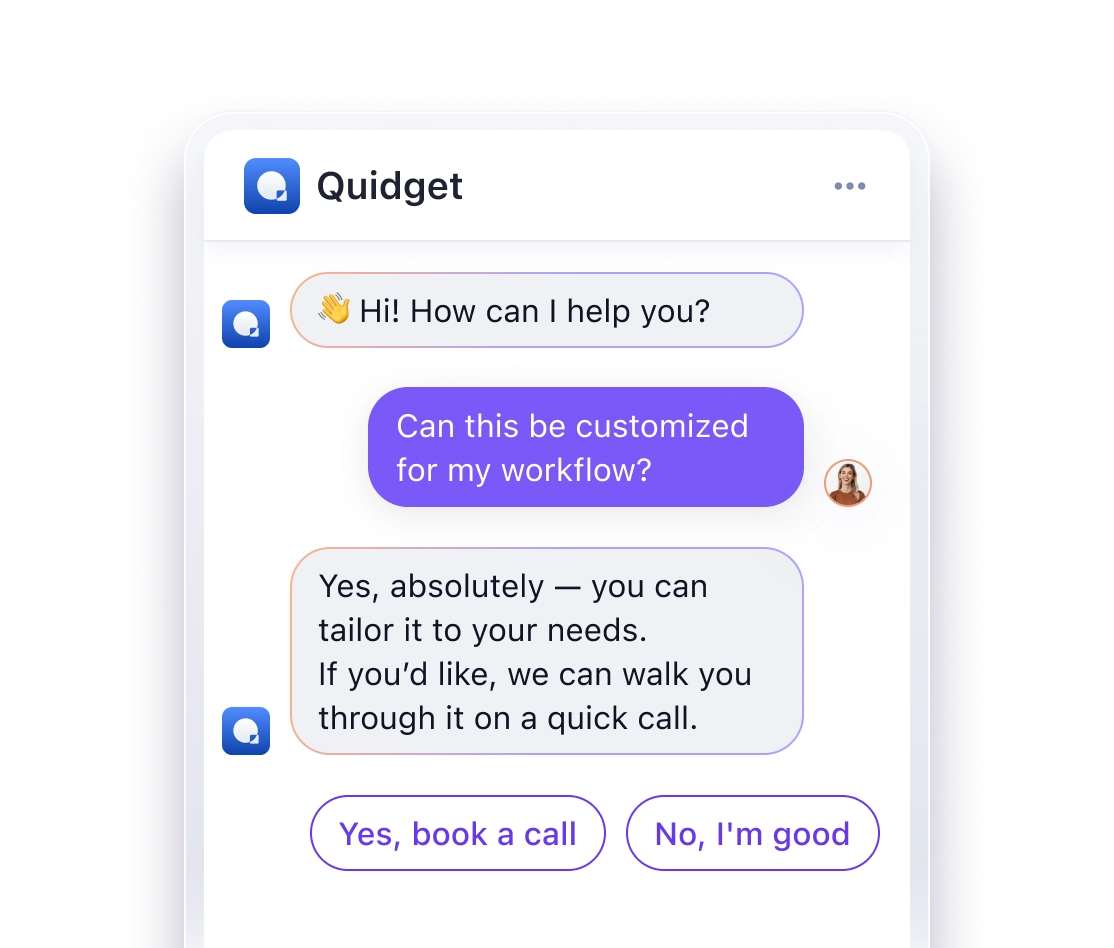Claude, GPT, Gemini, or Mistral? Here’s What Powers the Best AI Chatbots in 2025
AI chatbots now handle 95% of customer interactions, slashing service costs by 30% and boosting satisfaction by 20%. But which model is best for your business? The leaders in 2025 are Claude, GPT, Gemini, and Mistral – each excelling in different areas:
- Claude: Best for coding, ethical operations, and regulatory compliance with a 200k-token context window.
- GPT: Dominates the market with 60.6% share, offering great conversational fluency and multimodal support.
- Gemini: Excels in large-scale document processing with a massive 1M-token context window and multimodal capabilities.
- Mistral: The most cost-efficient option, ideal for high-speed, large-scale tasks with a focus on data sovereignty.
Here’s a quick comparison to help you decide:
| Model | Context Window | Strengths | Cost (Input/Output) |
|---|---|---|---|
| Claude | 200k tokens | Coding, compliance, safety | $3.00 / $15.00 per MTok |
| GPT | 1M tokens (GPT-4.1) | Multimodal, conversational fluency | $2.50 / $10.00 per MTok |
| Gemini | 1M+ tokens | Large-scale document processing | $3.44 blended |
| Mistral | 128k tokens | Affordable, fast, EU data sovereignty | $0.40 / $2.00 per MTok |
Each model has its niche. Claude is ideal for regulated industries, GPT is versatile for customer support, Gemini is perfect for extensive document handling, and Mistral is unbeatable for budget-conscious businesses. Choose based on your specific needs.
How to Pick the Right AI Tool in 2025 (Before You Waste Time!)
1. Claude
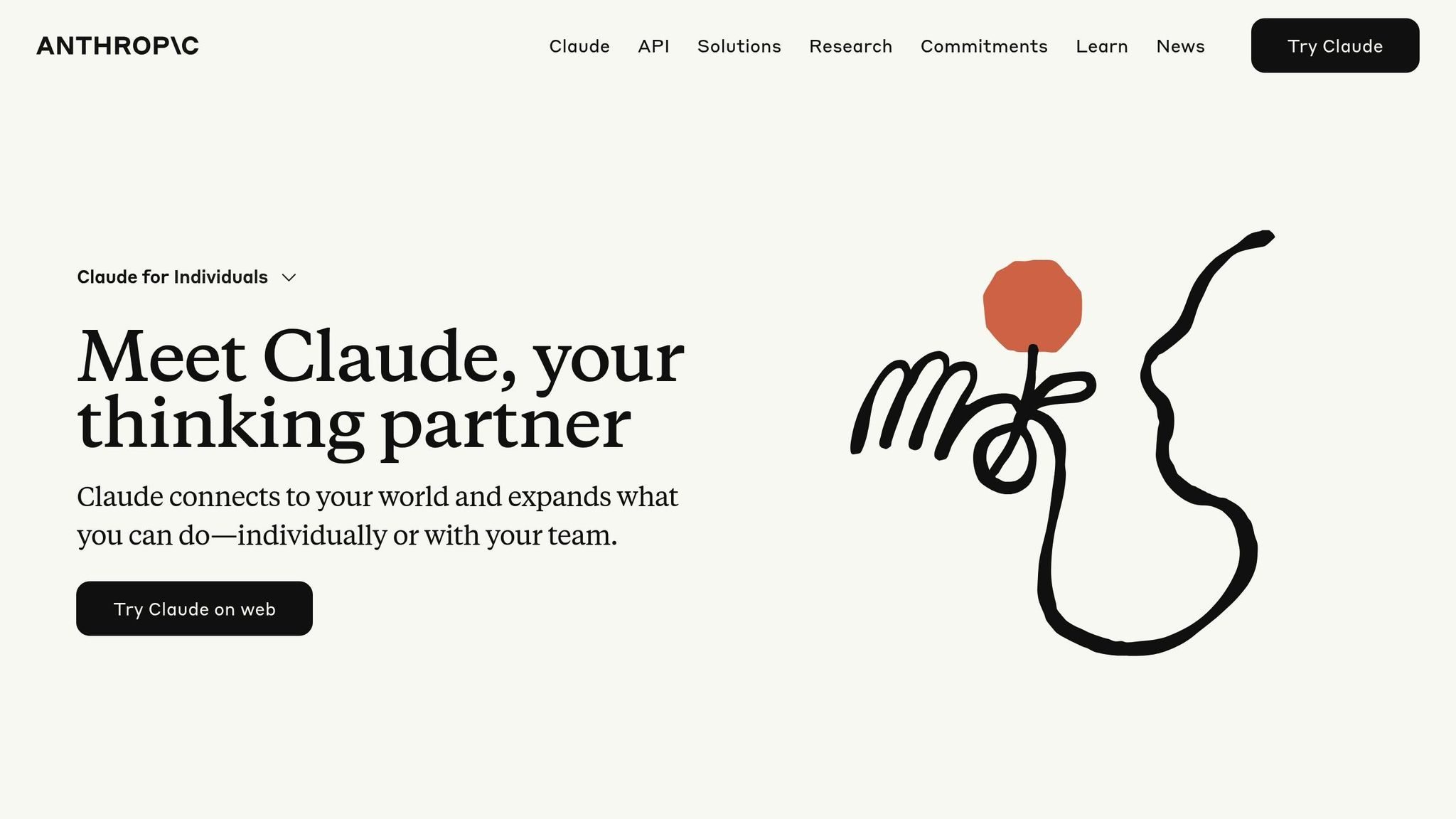
Claude is a standout in the AI chatbot world, particularly for its focus on safety and ethical operations. Developed by Anthropic, it’s built around the principles of Constitutional AI, embedding ethical guidelines directly into how it functions. This makes it a strong choice for businesses in highly regulated industries.
Context Window
Claude 3.5 Sonnet offers an impressive 200,000-token context window, with Enterprise plans extending this to a massive 500,000 tokens. This capacity allows it to handle extended conversations and lengthy documents without losing track of the context. For businesses managing complex queries or processing detailed documents, this feature ensures clarity and coherence throughout.
When the token limit is exceeded, Claude doesn’t silently truncate content. Instead, it provides a validation error, ensuring transparency in its operations.
Performance
Claude is particularly strong in areas like coding assistance, text analysis, and generating creative content. It handles complex, multi-step queries with ease and provides clear, actionable responses. Its reasoning capabilities make it an excellent tool for solving intricate problems or conducting detailed analyses. Combined with competitive pricing and a focus on safety, it’s a solid choice for industries that require strict adherence to regulations.
Cost Efficiency
Claude’s pricing is designed to be flexible, with options starting at $17 per month and going beyond $100, depending on business needs. API pricing varies based on the model, from $0.80 per million input tokens for Claude Haiku 3.5 to $15 per million input tokens for Claude Opus 4. Additional features, like web search, cost $10 per 1,000 searches, and organizations also benefit from 50 free hours of daily code execution.
Compliance and Safety
Claude’s design prioritizes safety and compliance, making it ideal for businesses in regulated sectors. Built on Constitutional AI, it integrates ethical standards into its core. Its AI Safety Level 3 protocols and regular external audits help reduce toxic speech incidents by 90% while increasing stakeholder trust by 50%.
Anthropic’s data privacy practices are equally robust. Prompts and outputs are automatically deleted from backend systems within 90 days, and consumer interactions are not used for training the model. For government applications, Claude GOV models are specifically designed to meet the highest confidentiality standards, operating only in classified environments.
Anthropic underscores the rigorous testing of its Claude GOV models:
"Anthropic expressly emphasizes that the Claude GOV models were subjected to the same rigorous security tests as all other Claude models of the company."
To further ensure responsible use, Claude’s Responsible Scaling Policy (RSP) includes a risk mitigation framework. The system undergoes joint evaluations by AI safety institutes in the US and UK for external validation.
With its balance of technical capabilities, ethical focus, and commitment to safety, Claude offers a reliable solution for businesses navigating complex regulatory landscapes.
2. GPT
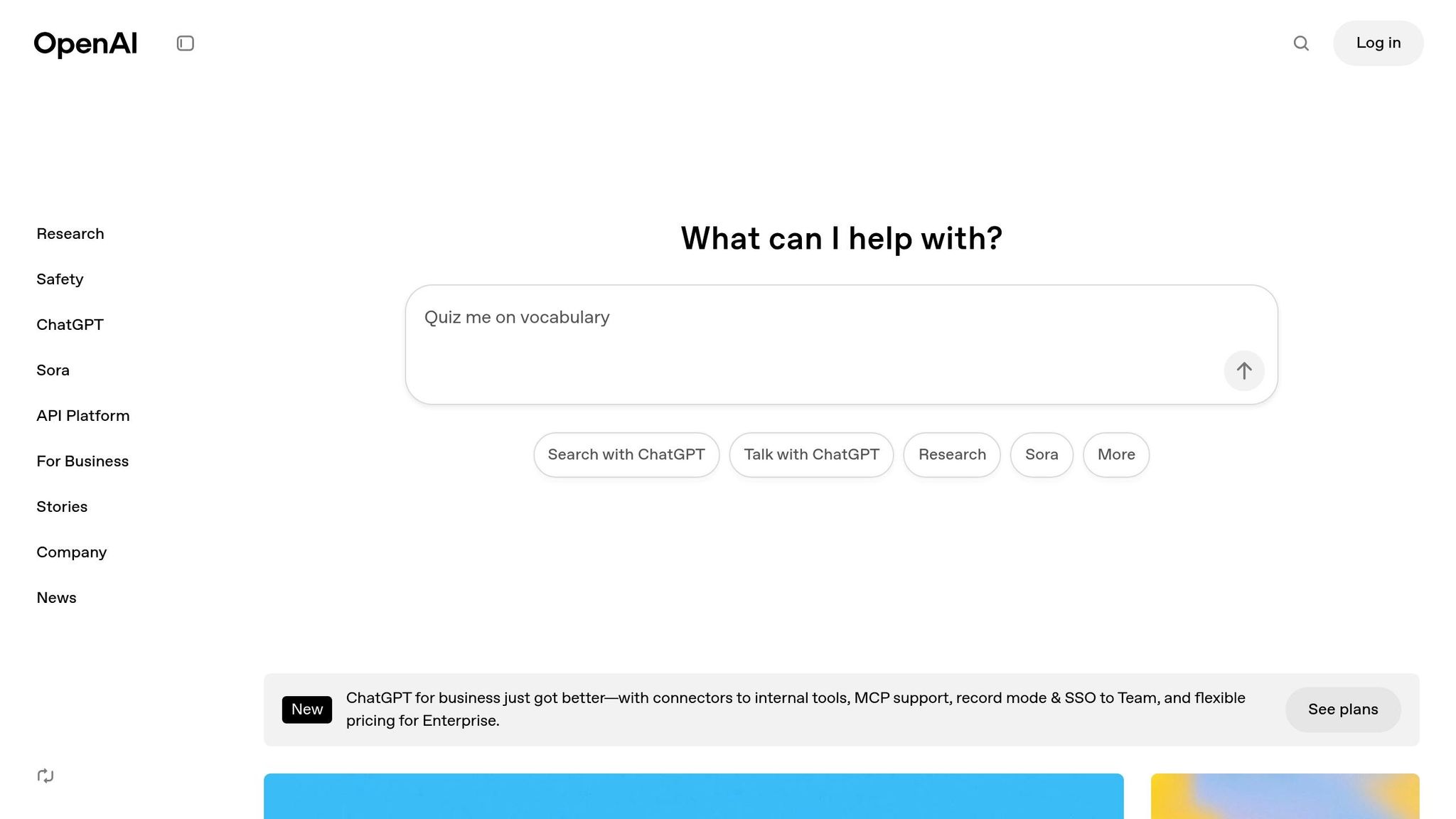
GPT continues to be a go-to AI model for chatbot development, known for its reliable and adaptable performance across various industries. OpenAI’s flagship model remains a leader in setting standards for conversational AI.
Context Window
The latest GPT-4.1 models can now handle up to 1 million tokens, a significant leap from the earlier GPT-4o models, which managed 128,000 tokens. Real-world tests by Thomson Reuters and Carlyle highlight improvements in document analysis accuracy – 17% and 50%, respectively. Features like context caching enhance efficiency by cutting costs and reducing latency, making long-context applications smoother. With these advancements, GPT ensures better retention of conversation details, boosting both accuracy and response speed.
Performance
The performance of GPT models has seen notable improvements in 2025. GPT-4o now achieves an 88.7% accuracy score on the MMLU benchmark, while GPT-4 shows a 40% increase in delivering factual responses. Its ability to process up to 25,000 words makes it particularly suited for analyzing lengthy business documents or managing detailed discussions. Response times have also improved, with GPT-4o averaging 0.8 seconds per reply and the optimized GPT-4.5 reducing this further to 0.6 seconds. Additionally, GPT-4.1 has enhanced instruction-following by 10.5% over GPT-4o, particularly in multi-turn conversations.
Maintaining accuracy over time requires consistent monitoring. As Mohamed Ezz, Founder & CEO of MPG ONE, points out:
"What really matters is context because accuracy changes based on the task, the topic, and even how you phrase your question."
In healthcare, for instance, a customized GPT model for patient communication reduced medical terminology errors from 12% to under 2%. These improvements link directly to both cost management and expanded use cases.
Cost Efficiency
GPT offers flexible pricing to accommodate different business needs. GPT-4 is currently priced at $0.012 per 1,000 prompt tokens and $0.024 per 1,000 completion tokens, while GPT-3.5 costs $0.002 per 1,000 tokens. A mid-sized application managing about 100,000 queries monthly might spend between $3,000 and $7,000, plus additional cloud hosting costs ranging from $500 to $3,000.
AI-driven chatbots, like Quidget, have been shown to increase user session lengths by 30–50%, and automating 50–80% of support tickets can save businesses over $10,000 per month. However, since 40% of businesses underestimate the costs of integrating ChatGPT, careful budgeting and cost management are crucial.
Multimodal Support
GPT’s capabilities extend beyond text. Its multimodal functionality allows it to process and respond to varied content types, such as images, documents, and other media. This makes it invaluable in scenarios like retail support, where it can handle visual content, or professional services, where it can analyze complex documents.
Compliance and Safety
GPT has made strides in safety and compliance. It now rejects harmful requests 89% of the time, up from GPT-3’s 45%. The model has also improved its ability to reduce biased statements, with performance increasing from 62% to 91%. Its fact-checking accuracy has more than doubled, rising from 38% to 79%, which is vital for business applications requiring precise and responsible outputs.
That said, businesses should remain cautious. It’s essential to implement robust verification processes to minimize risks. Using clear, specific prompts can guide the model toward accurate responses, and regular monitoring and updates are key to maintaining reliability.
3. Gemini
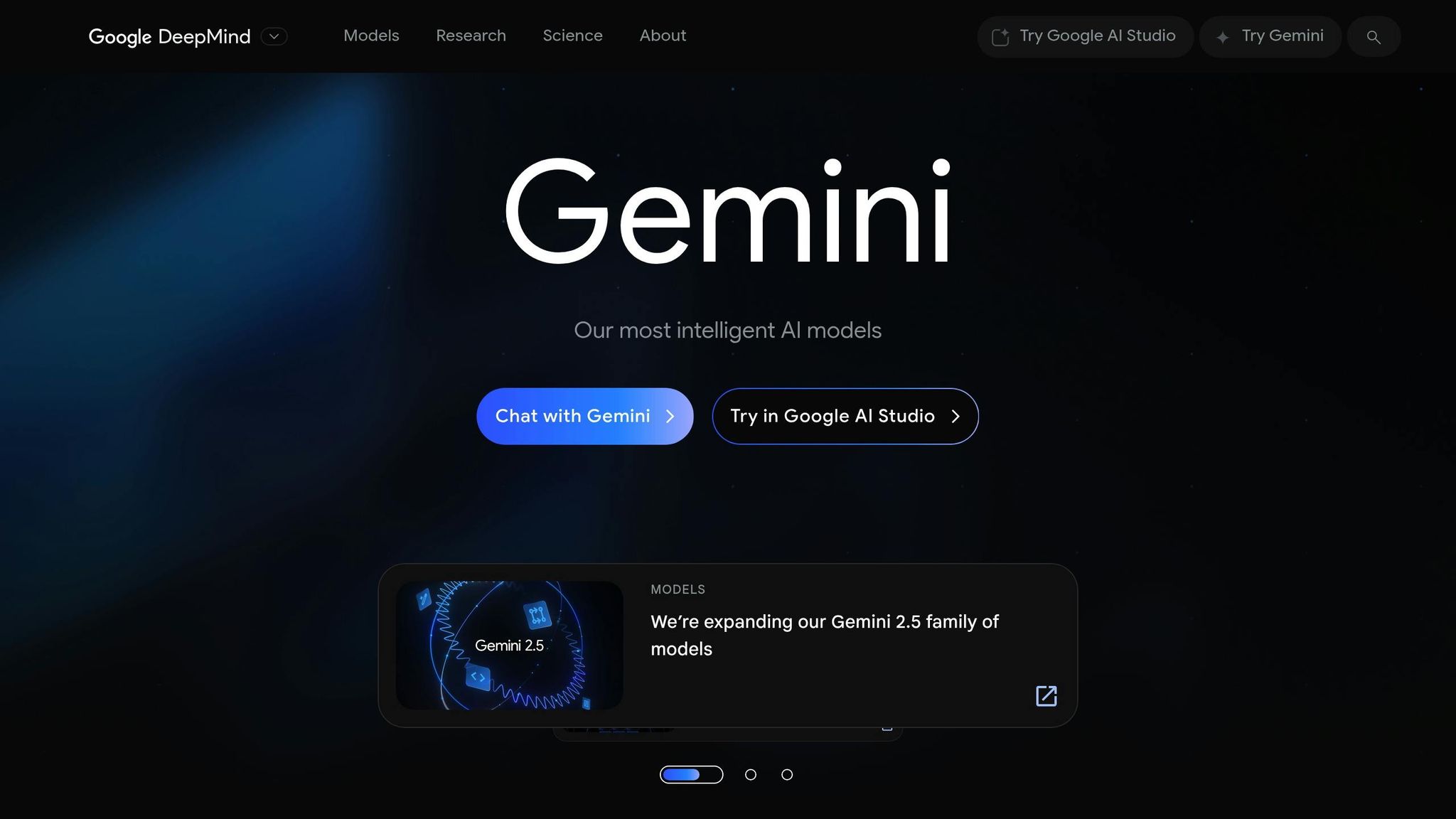
Google’s Gemini is making waves as an AI model designed to integrate seamlessly into business operations. With an impressive 400 million monthly active users, it has demonstrated its ability to tackle essential business tasks while offering flexible deployment options. Let’s break down its strengths in performance, cost, and functionality.
Performance
Gemini 2.5 Flash is a step forward in efficiency, using 20–30% fewer tokens compared to earlier versions. This improvement means faster processing and better responses, particularly for high-demand chatbot applications. It also excels in handling large-scale documentation, with Gemini 2.0 Flash processing a 6,000-page PDF for just about $1. This capability makes it a go-to choice for businesses managing extensive document workflows.
Cost Efficiency
Gemini provides a tiered pricing model to suit various business needs:
| Model | Input ($/1M tokens) | Output ($/1M tokens) |
|---|---|---|
| Gemini 2.5 Flash-Lite | $0.10 (text/image/video) | $0.40 |
| Gemini 1.5 Flash-8B | $0.0375 (≤128k tokens) | $0.15 (≤128k tokens) |
| Gemini 2.5 Flash | $0.30 (text/image/video) | $2.50 |
| Gemini 2.5 Pro | $1.25 (≤200k tokens) | $10.00 (≤200k tokens) |
For businesses handling high volumes of interactions, Gemini 2.5 Flash-Lite offers an economical solution, making it ideal for customer support chatbots managing thousands of queries daily.
Multimodal Support
Gemini’s ability to process text, images, video, and audio enhances its versatility. This multimodal functionality allows chatbots to engage dynamically with users. Gemini Live takes it further by enabling real-time conversations during video streaming or screen sharing, creating a more interactive experience. For more specialized tasks, the Deep Research feature can analyze uploaded PDFs and images to generate tailored research reports for specific business needs.
Compliance and Safety
Gemini addresses enterprise security concerns with flexible deployment options. Its models, hosted on Nvidia Blackwell GPUs via Google Cloud, ensure data security whether deployed in the cloud or on-premises. Nvidia Blackwell’s confidential computing safeguards user prompts and fine-tuning data during processing. Additionally, Google Cloud’s HIPAA eligibility and willingness to sign Business Associate Agreements highlight its readiness for regulated industries.
One standout example is MEDITECH, which adopted Gemini in March 2025. By automating tasks like note-taking and email drafting, the company saved an average of seven hours per employee per week. MEDITECH also ensured that internal data remained private and excluded from AI training. As its president and CEO noted, "Adopting Gemini is the right thing to do". With reports showing that 38% of employees share sensitive work data with AI without employer knowledge, Gemini’s security features and access controls are critical.
These measures bring tangible benefits for enterprise use:
"Gemini on Google Distributed Cloud will empower ServiceNow to augment powerful agentic AI capabilities such as reasoning in our existing systems via robust APIs. This strategic deployment allows us to explore and implement cutting-edge advancements while upholding our commitment to customer trust and data protection." – Pat Casey, Chief Technology Officer & EVP of DevOps, ServiceNow
For businesses looking to explore Gemini, Google AI Studio offers a free tier for testing, with paid options for increased rate limits and additional features. This approach makes it easy to evaluate Gemini’s potential before committing to a full-scale rollout, solidifying its position as a top choice for enterprise AI solutions.
4. Mistral
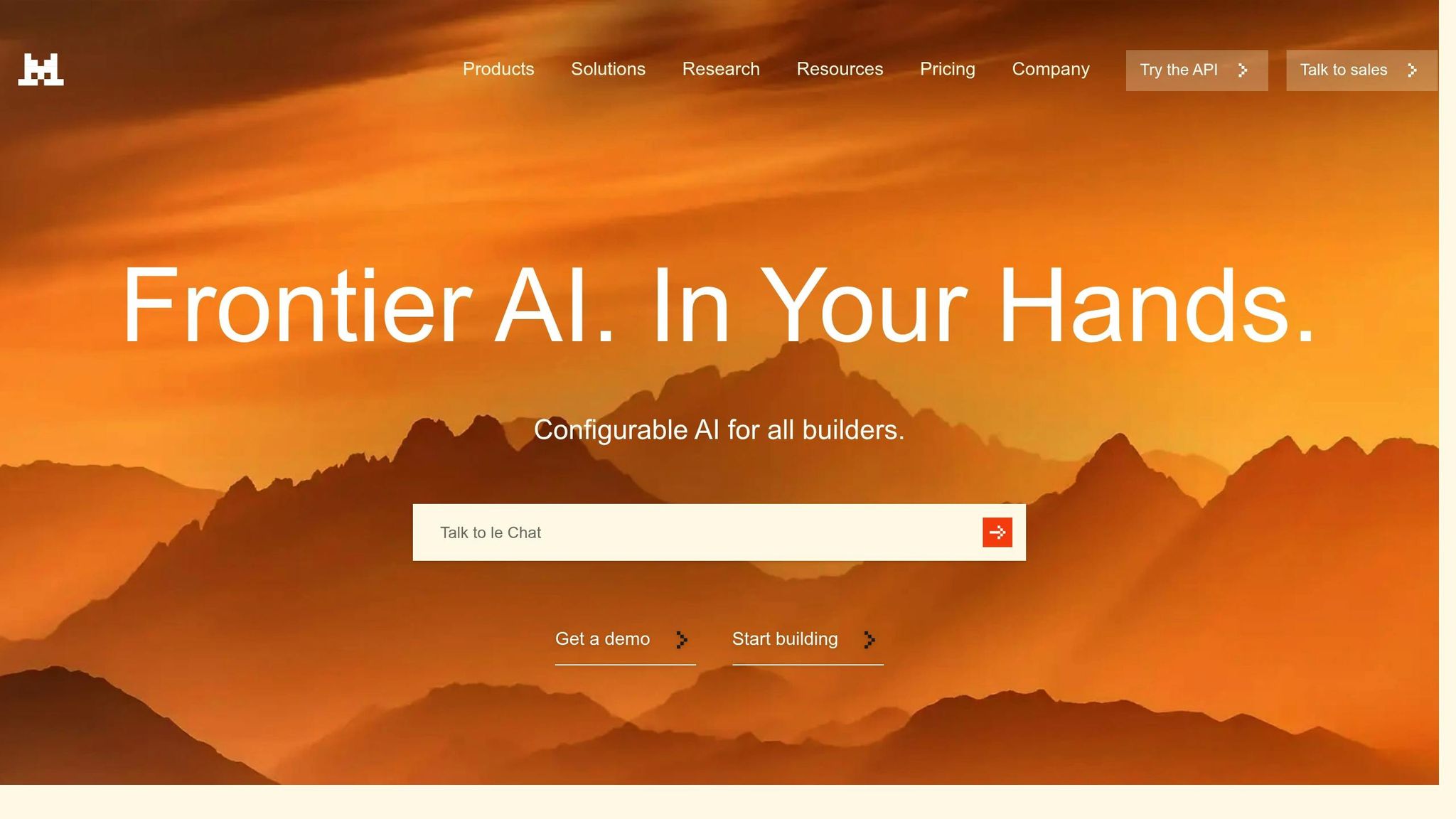
Mistral AI offers a European alternative for enterprises, blending strong performance with cost-conscious solutions and a focus on data sovereignty. With the launch of its Le Chat Enterprise platform and the Medium 3 model, Mistral is carving out a space in the enterprise chatbot market. Below, we’ll explore its performance, pricing, and compliance features.
Performance
Mistral’s Medium 3 model delivers impressive results, achieving over 90% of the performance of pricier competitors while processing 1,000 words per second. And it does so at a fraction of the cost – $0.40 per million input tokens and $2 per million output tokens. The model particularly shines in coding and STEM-related tasks.
Le Chat, Mistral’s chatbot platform, combines pre-trained knowledge with live updates from sources like web searches, news outlets, and social media. This makes it a dynamic tool for businesses needing up-to-date information in their AI-powered interactions.
Mistral’s rapid growth underscores its market traction. CEO Arthur Mensch shared:
"In the last 100 days we have tripled our business, in particular in Europe and outside of the U.S."
This expansion highlights the increasing demand for non-U.S.-based AI providers, especially among European companies seeking alternatives.
Cost Efficiency
Mistral’s pricing is a major draw, offering substantial savings compared to competitors. For instance, Medium 3 costs $0.40 per million input tokens and $2 per million output tokens, while Anthropic’s Claude Sonnet 3.7 comes in at $3 per million input tokens and $15 per million output tokens. That’s an 8X cost reduction without sacrificing much in performance.
For lighter workloads, Mistral Small 3.1 provides an even more affordable option at $0.10 per million input tokens and $0.30 per million output tokens. This tiered pricing structure allows businesses to align their AI spending with their specific needs.
Mistral also keeps infrastructure costs in check. Medium 3 can run on as few as four GPUs, making self-hosting a practical option for companies with modest hardware setups. This flexibility not only reduces long-term expenses but also gives businesses greater control over their data environments.
Multimodal Support
Mistral’s Pixtral 12B is its first multimodal model, designed to handle both text and image inputs. Trained on interleaved data, it supports variable image sizes, aspect ratios, and even multiple images within its 128,000-token context window.
Pixtral 12B performs well on tasks requiring reasoning and multimodal instruction, achieving 52.5% on the MMMU benchmark and outpacing open-source alternatives. It’s practical for use cases like:
– Extracting structured data from multiple images
– Generating HTML from visual mockups
– Analyzing charts to answer data-driven questions
This capability enables chatbots to handle visual content seamlessly, whether it’s assisting customers with product images or analyzing technical documents.
Compliance and Safety
Mistral prioritizes data sovereignty, appealing to enterprises with strict regional data regulations, particularly in Europe. By minimizing reliance on U.S.-based cloud providers, Mistral addresses concerns about data residency and compliance.
Le Chat Enterprise integrates productivity tools and security features into a single platform. It also includes an AI agent builder, allowing teams to create custom assistants without needing to code. As Mistral puts it:
"Le Chat will enable your team to easily build custom assistants that match your own requirements – no code required"
One standout example is Mistral’s partnership with Stellantis, where AI is applied across vehicle engineering and manufacturing. This collaboration includes creating an in-car assistant for natural language interactions, optimizing component databases, and improving production efficiency through real-time anomaly detection.
Mistral also offers fine-tuning via API, enabling businesses to tailor models to specific datasets and workflows. This customization enhances both performance and efficiency while ensuring sensitive data stays under the company’s control.
sbb-itb-58cc2bf
Model Comparison: Advantages and Disadvantages
This section breaks down the key strengths and trade-offs of each model, focusing on context window capacity, costs, multimodal features, and compliance. Use this comparison to align your choice with your business priorities.
| Model | Context Window | Input Cost (per MTok) | Output Cost (per MTok) | Key Strengths | Main Weaknesses |
|---|---|---|---|---|---|
| Claude 3.7 Sonnet | 200,000 tokens | $3.00 | $15.00 | Strong reasoning and document analysis | Higher cost; subject to U.S. regulations |
| GPT-4o | 128,000 tokens | $2.50 | $10.00 | Multimodal capabilities and versatility | Moderate pricing; smaller context window |
| Gemini 2.5 Pro | 1,048,576 tokens | $3.44 (blended) | – | Massive context window | May face certain U.S. regulatory limits |
| Mistral Small 3.1 | 128,000 tokens | $0.20 | $0.60 | Affordable and EU data sovereignty | Limited ecosystem |
Context Window Capacity
The size of a model’s context window can significantly impact its performance. Gemini 2.5 Pro stands out with a staggering capacity of over 1 million tokens, allowing it to handle extensive documents like entire books or large datasets in one go. Claude 3.7 Sonnet follows with a 200,000-token capacity, making it a solid choice for processing long, complex documents. GPT-4o and Mistral Small 3.1 both support 128,000 tokens, which is still a major improvement over older models.
Cost Efficiency
Pricing varies widely across these models. Mistral Small 3.1 is the most budget-friendly, with input costs at $0.20 and output costs at $0.60 per million tokens. This makes it a great option for businesses managing high volumes of straightforward tasks. On the other end, Claude 3.7 Sonnet has the highest costs – $3.00 for input and $15.00 for output – justifiable only for tasks demanding its advanced reasoning capabilities. GPT-4o balances cost and functionality at $2.50 for input and $10.00 for output. Gemini’s blended pricing of $3.44 assumes a common 3:1 input-to-output ratio.
Multimodal Capabilities
Models with multimodal abilities are especially useful for tasks requiring simultaneous processing of text, images, and audio. GPT-4o excels in this area, handling multiple formats effortlessly. Mistral has also introduced Pixtral 12B, a variant designed for image processing, achieving an impressive 52.5% on the MMMU benchmark.
Compliance Considerations
For businesses handling sensitive data, regulatory alignment is a key factor. Mistral operates under EU jurisdiction, adhering to GDPR standards. Unlike OpenAI and Google, it is not bound by the U.S. CLOUD Act, which makes it a safer choice for organizations prioritizing data sovereignty within European infrastructure.
Performance Trade-Offs
Each model has its niche strengths. Claude 3.7 Sonnet shines in complex reasoning tasks, making it ideal for industries like finance or law. GPT-4o’s multimodal capabilities make it a versatile option for customer-facing roles. Gemini’s large context window is perfect for internal tools that need to process extensive knowledge bases. Meanwhile, Mistral Small 3.1’s affordability makes it a go-to for high-volume, repetitive tasks.
The best model for your needs will depend on your priorities. If you’re handling intricate analyses, Claude may justify its higher pricing. For cost-conscious operations, Mistral offers significant savings. Gemini is unmatched for large-scale document processing, while GPT-4o is the best fit for diverse, multimodal tasks.
Conclusion
AI models offer a range of options tailored to different business needs, from customer support to content creation and large-scale data processing. The key isn’t about finding a one-size-fits-all solution – it’s about aligning the model’s strengths with your specific goals and workflow. Each model comes with its own balance of cost, performance, and capabilities, allowing businesses to choose what works best within their budget and priorities.
For customer support teams, GPT-4o provides a versatile solution with its multimodal capabilities, making it well-suited for handling a variety of customer inquiries. Tools like Quidget take advantage of GPT’s adaptability, automating up to 80% of routine questions while ensuring smooth transitions to human agents when needed.
Content creation and marketing teams may find Claude particularly useful. It’s known for producing high-quality, empathetic written content, making it a strong choice for teams that prioritize creativity and have the flexibility to invest in premium tools.
When it comes to enterprise operations requiring the processing of large documents, Gemini 2.5 Pro shines. Its expansive context window allows it to analyze entire books or datasets in a single pass, making it invaluable for creating and maintaining detailed internal knowledge bases.
For high-speed, large-scale processing, Mistral Small 3.1 stands out. Its Le Chat model boasts the fastest inference speeds in the market, outperforming competitors like Claude and GPT. This makes it an excellent choice for scenarios where speed and efficiency are non-negotiable.
While these AI models enhance productivity and streamline processes, they’re not replacements for human intuition or ethical judgment. Instead, they work best as tools that complement and amplify human expertise, ensuring a balance between technology and human insight.
FAQs
How can I select the best AI chatbot model for my business in 2025?
How to Choose the Right AI Chatbot Model for Your Business in 2025
When selecting an AI chatbot model for your business, start by defining what you need it to do. Are you looking to improve customer support, assist with sales inquiries, or streamline workflow automation? Pinpointing your goals will help you focus on the features that matter most.
Pay attention to how the chatbot handles multimodal interactions – whether it can communicate through text, voice, or even images. Features like emotional intelligence and predictive capabilities are also becoming increasingly important, as they can significantly improve how the chatbot interacts with users and anticipates their needs.
Another key consideration is the model’s scalability and energy usage. Larger AI models often require more resources, which can impact both costs and environmental sustainability. Make sure the chatbot aligns with your industry’s demands and your company’s long-term objectives. By doing so, you’ll not only improve the user experience but also enhance your business operations.
What are the costs of using AI chatbot models like Claude, GPT, Gemini, and Mistral in 2025?
The Cost of AI Chatbot Models in 2025
Prices for AI chatbot models in 2025 vary widely, depending on the provider and how you plan to use them. For instance, Claude Pro and Gemini Advanced are both available at around $20 per month, offering an affordable option for many users. On the more economical side, Mistral models come in at roughly one-eighth of the cost of Claude or Gemini, making them a budget-friendly alternative.
At the premium end, GPT-4 offers tiers ranging from $20 to $250 per month, while enterprise solutions can soar to as much as $1 million annually.
When deciding which model to go with, don’t just focus on the subscription cost. Think about how well the model fits your specific business needs. Performance and scalability can play a big role in determining the overall value you get.
How do Mistral and Claude address compliance and data sovereignty needs for businesses in regulated industries?
Compliance and Data Sovereignty: Mistral vs. Claude
Mistral stands out for businesses prioritizing data control within the European Union. It adheres to regulations like GDPR and operates exclusively on European infrastructure, ensuring data stays within EU borders.
Claude, on the other hand, is tailored for U.S. compliance needs. With certifications like FedRAMP High and DoD IL4/5, it meets the demanding standards required by government agencies and security-sensitive industries.
Both models are well-suited for sectors such as healthcare, finance, and government, where secure and regulation-compliant data management is a top priority.



